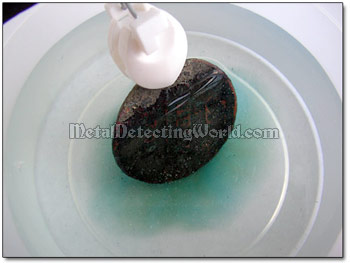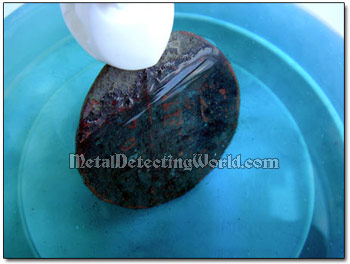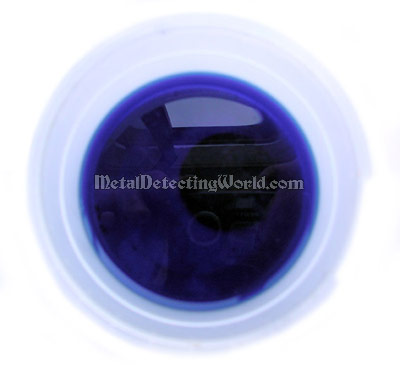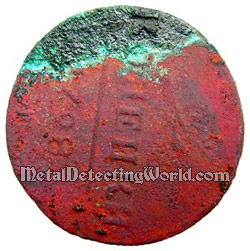A Complete Guide To Cleaning and Preservation of Coins, page 13
CHEMICAL COIN CLEANING: Ammonia, Vinegar and Salt, Lemon Juice and Olive Oil Immersion Baths
(...CONTINUED)
The following methods can be also used to remove the coin's crust, coin metal oxides, coin tarnish and some types of coating.
• Ammonia Solution Immersion Bath
The coin is immersed into a 10% Ammonia (NH4OH) solution. The container must be tightly covered with a lid, and the coin must be immersed completely (unlike in the picture below). The process begins immediately and is evidenced by changing color, from clear to dark-blue or violet, of the solution, starting around the coin. This is an effect of ammonia not only on the dirt, but also on the coin's patina, basic copper sulfate, that is dissolving in the solution.

Solution In 2 Hours

The coin is immersed for a few minutes or continually taken out, soaked with several changes of water and brushed. Great care must be exercised here. If the coin is left for longer time, the entire bath turns dark-blue, and the coin completely loses its patina and turns red.

A brief immersion in 5% hydrochloric acid then follows for neutralization. This is how the coin looks like after the treatment; the remaining green spot on the coin, the only area that was not immersed into the solution, is left for comparison.

If dark spots remain under the previous verdigris, they are simply left there, because copper retarnishes very quickly. The copper coin then can be either brightened (see "Brightening Copper Coins" on page 21) or tarnished (see "Tarnishing Copper Coins" on page 22) or artificially patinated (see "Artificial Patination of Copper Coins" on page 23) over the entire surface, or on parts of the surface by using a Q-Tip.
IMPORTANT NOTE: If the coin is placed flat on the container's bottom instead of being suspended into solution (as shown on the picture), it must be turned over a few times (at equal time intervals) while staying COMPLETELY immersed. When the coin with ammonia solution on its surface is taken out of the bath, THE COIN MIGHT BE SERIOUSLY DAMAGED IF EXPOSED TO THE AIR for a long moment!
• Vinegar and Salt Bath
This effective and inexpensive method is used to quickly clean coins destined to be exchanged at the bank, for example, clad types, nickels, and pennies. A large glass jar is half filled with distilled white vinegar. Then the coins of the same composition are added.
NOTE: Coins of unlike compositions mixed together will definitely stain each other using this method.
Next, add a tablespoon of table salt while stirring the coins continuously with a wooden spatula. Within minutes you will see the results. Stop stirring when you think the coins are clean enough. Coins left too long in this mixture can actually have their surface features etched away. A fresh mixture of vinegar and salt for each batch of coins is recommended.
After immersion, the action of the chemicals must be stopped by rinsing or washing the coins with distilled water. In many cases, a neutralization must take place to stop the further attack on the coins. This neutralization is accomplished by immersing the pieces in a solution that reacts oppositely. Acid is thus neutralized by alkali, and alkali by acid.
• Lemon Juice and Olive Oil Hot Bath
This method is used for fast and safe removal of encrustation from silver coins only. Using this method for cleaning the copper and copper-alloyed coins is not practical as the Lemon Juice/Olive Oil mix removes all oxides including the copper oxide which forms patina on copper coins. Removing patina from the copper coins may not only reveal ugly spots at which the coin metal has been damaged by oxidation, but also remove the coin detail if it has been transformed into the copper oxide.
The same goes for the silver coins of low silver content (Millesimal Fineness below 0.203 - 20% silver in alloy). If the copper in the alloy is oxidized, this treatment will cause pitting on the coin's surface.
To remove the encrustation and hard deposits off a silver coin, add 1 teaspoon of lemon juice to 1.5 cups of olive oil, mix well, place the mix into a glass or ceramic container, and place the coin in it. Take a larger pot, place your container with the mix and the coin inside the pot, add water to a level below the non-metal container's rim, and put the pot on burner with low flame to heat up both the water and the Lemon Juice/Olive Oil bath in your non-metal container. Keep the water hot but below boiling point.
This treatment may remove all deposits or most of them off the coin's surface. In any case, remove the coin from the container, toothbrush it with Pepsodent original toothpaste under running water to remove any residue including oil, wash the coin with non-detergent soap, soak the coin in distilled water for a little while, and then dehydrate it in acetone. If the results of cleaning are satisfactory, coat the coin with microcrystalline wax to protect it from tarnishing. If some hard encrustation remains on the coin, subject it to cleaning with Electrolysis (electrolytic reduction cleaning method is described on page 15).